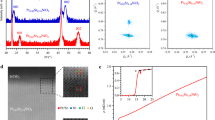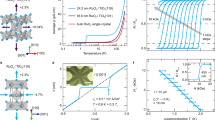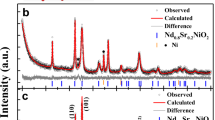Abstract
The discovery1 of high-temperature superconductivity in copper oxides raised the possibility that superconductivity could be achieved at room temperature. But since 1993, when a critical temperature (T c) of 133 K was observed in the HgBa2Ca2Cu3O8+δ (ref. 2), no further progress has been made in raising the critical temperature through material design. It has been shown, however, that the application of hydrostatic pressure can raise T c — up to ∼164 K in the case of HgBa2Ca2Cu3O8+δ (ref. 3). Here we show, by analysing the uniaxial strain and pressure derivatives of T c, that compressive epitaxial strain in thin films of copper oxide superconductors could in principle generate much larger increases in the critical temperature than obtained by comparable hydrostatic pressures. We demonstrate the experimental feasibility of this approach for the compound La1.9Sr0.1CuO4, where we obtain a critical temperature of 49 K in strained single-crystal thin films — roughly double the bulk value of 25 K. Furthermore, the resistive behaviour at low temperatures (but above T c) of the strained samples changes markedly, going from insulating to metallic.
This is a preview of subscription content, access via your institution
Access options
Subscribe to this journal
Receive 51 print issues and online access
$199.00 per year
only $3.90 per issue
Buy this article
- Purchase on Springer Link
- Instant access to full article PDF
Prices may be subject to local taxes which are calculated during checkout




Similar content being viewed by others
References
Bednorz, J. G. & Müller, K. A. Possible high T csuperconductivity in the Ba–La–Cu–O system. Z. Phys. B 64, 189–193 (1986).
Schilling, A., Cantoni, M., Guo, J. D. & Ott, H. R. Superconductivity above 130 K in the Hg–Ba–Ca–Cu–O system. Nature 362, 56–58 (1993).
Gao, L.et al. Superconductivity up to 164 K in HgBa2Cam −1CumO2 m +2+δ(m = 1, 2 and 3) under quasihydrostatic pressures. Phys. Rev. B 50, 4260–4263 (1994).
Bud'ko, S. L., Guimpel, J., Nakamura, O., Maple, M. B. & Schuller, I. K. Uniaxial pressure dependence of the superconducting critical temperature in RBa2Cu3O7−δ high T coxides. Phys. Rev. B 46, 1257–1260 (1992).
Belenky, G. L.et al. Effect of stress along the ab plane on the J c and T cof YBa2Cu3O7thin films. Phys. Rev. B 44, 10117–10120 (1991).
Sato, H. & Naito, M. Increase in the superconducting transition temperature by anisotropic strain effect in (001) La1.85Sr0.15CuO4thin films on LaSrAlO4substrates. Physica C 274, 221–226 (1997).
Locquet, J.-P. & Williams, E. J. Epitaxially induced defects in Sr- and O-doped La2CuO4thin films grown by MBE: implications for transport properties. Acta Polonica A 92, 69–84 (1997).
Nohara, M.et al. Unconventional lattice stiffening in superconducting La2− xSrxCuO4single crystals. Phys. Rev. B 52, 570–580 (1995).
Gugenberger, F.et al. Uniaxial pressure dependence of T c from high resolution dilatometry of untwinned La2− xSrxCuO4single crystals. Phys. Rev. B 49, 13137–13142 (1994).
Welp, U.et al. Effect of uniaxial stress on the superconducting transition in YBa2Cu3O7. Phys. Rev. Lett. 69, 2130–2133 (1992).
Meingast, C.et al. Large a – b anisotropy of the expansivity anomaly at T cin untwinned YBa2Cu7−δ. Phys. Rev. Lett. 67, 1634–1637 (1991).
Meingast, C., Junod, A. & Walker, E. Superconducting fluctuations and uniaxial pressure dependence of T cof a Bi2Sr2CaCu2O8+ xsingle crystal from high resolution thermal expansion. Physica C 272, 106–114 (1996).
Fukamachi, K.et al. in Advances in Superconductivity Vol. VII (eds Yamafuji, K. & Morishita, T.) 225–228 (Springer, Tokyo, (1995)).
Chen, X., Tessema, G. X. & Skove, M. J. Effects of elastic stress on the resistivity and T cof (Bi,Pb)2Sr2Can −1CunOx. Physica C 181, 340–344 (1991).
Tanahashi, N.et al. The strontium content dependence of pressure effect in (La1− xSrx)2CuO4. Jpn J. Appl. Phys. 28, L762–L765 (1989).
Yamada, N. & Ido, M. Pressure effects on superconductivity and structural phase transitions in La2− xMxCuO4(M = Ba, Sr). Physica C 203, 240–246 (1992).
Fartash, A., Grimsditch, M., Fullerton, E. E. & Schuller, IvanK. Breakdown of Poisson's effect in Nb/Cu superlattices. Phys. Rev. B 47, 12813–12819 (1993).
Locquet, J.-P. & Mächler, E. Block-by-block deposition of complex oxide films. Mater. Res. Soc. Bull. 19, 39–43 (1994).
Triscone, J.-M.et al. YBa2Cu3O7/PrBa2Cu3O7superlattices: Properties of ultrathin superconducting layers separated by insulating layers. Phys. Rev. Lett. 64, 804–807 (1990).
Terashima, T.et al. Superconductivity of one-unit-cell thick YBa2Cu3O7thin film. Phys. Rev. Lett. 67, 1362–1365 (1991).
Matthews, J. W. & Blakeslee, A. E. Defects in epitaxial multilayers. J. Cryst. Growth 27, 118–125 (1994).
Locquet, J.-P.et al. Variation of the in-plane penetration depth λab as a function of doping in La2− xSrxCuO4±δthin films on SrTiO3: implications for the overdoped state. Phys. Rev. B 54, 7481–7488 (1996).
Tresse, F. Cristallochimie de Quelques Oxides des Éléments de Transition: Influence de la présence d'oxygène et de Substitutions Cationiques sur la Supraconduction Thesis, Univ. Bordeaux (1990).
Hojczyk, R., Jia, C.-L., Poppe, U. & Urban, K. New insulating materials for high T csuperconductor device applications. Physica C 282–287;, 731–732 (1997).
Radaelli, P. G.et al. Structural and superconducting properties of La2− xSrxCuO4 as a function of Sr content. Phys. Rev. B 49, 4163–4175 (1994).
Fullerton, E. E., Schuller, I. K., Vanderstraeten, H. & Bruynseraede, Y. Structural refinements from x-ray diffraction. Phys. Rev. B 45, 9292–9310 (1992).
Kimura, T.et al. In-plane and out-of-plane magnetoresistance in La2− xSrxCuO4single crystals. Phys. Rev. B 53, 8733–8742 (1996).
Nakano, T.et al. Magnetic properties and electronic conduction of superconducting La2− xSrxCuO4. Phys. Rev. B 49, 16000–16008 (1994).
Williams, G. V. M., Tallon, J. L., Haines, E. M., Michalak, R. & Dupree, R. NMR evidence for a d-wave normal state pseudogap. Phys. Rev. Lett. 78, 721–724 (1997).
Anderson, P. W. The Theory of Superconductivity in the High TcCuprate Superconductors (Princeton Univ. Press, (1997)); C-axis electrodynamics as evidence for the interlayer theory of high temperature superconductivity. Science 279, 1196–1198 (1998).
Acknowledgements
We thank Y. Jaccard, F. Arrouy and E. J. Williams for contributions in the initial phase of this project; P. Martinoli, Ø. Fischer, J.-M. Triscone, J. G. Bednorz and C. Rossel for discussions; and C. Voisard and T. Maeder for the thermal expansion measurements. This work was supported by the Swiss National Science Foundation, the Swiss Priority Project “Minast”, and the Belgian UIAP 4/10.
Author information
Authors and Affiliations
Corresponding author
Rights and permissions
About this article
Cite this article
Locquet, JP., Perret, J., Fompeyrine, J. et al. Doubling the critical temperature of La1.9Sr0.1CuO4 using epitaxial strain. Nature 394, 453–456 (1998). https://doi.org/10.1038/28810
Received:
Accepted:
Issue Date:
DOI: https://doi.org/10.1038/28810
This article is cited by
-
Film Thickness Dependence of the Critical Temperature of Superconductivity of LSCO Films: A Bipolaron Model Approach
Journal of Low Temperature Physics (2023)
-
Holographic supersolids
Journal of High Energy Physics (2022)
-
Substrate and thickness influence on YBa\(_2\)Cu\(_3\)O\(_{7-\delta }\) thin films grown by PLD deposition
Applied Physics A (2022)
-
Effects of li doping on superconducting properties of citrate-gel prepared Y1–xLixBa2Cu3O7–δ Compound
Applied Physics A (2022)
-
On the Critical Temperature of Superconductivity of La\(_{2-x}\)Sr\(_{x}\)CuO\(_{4}\) Thin Films
Journal of Superconductivity and Novel Magnetism (2022)
Comments
By submitting a comment you agree to abide by our Terms and Community Guidelines. If you find something abusive or that does not comply with our terms or guidelines please flag it as inappropriate.



